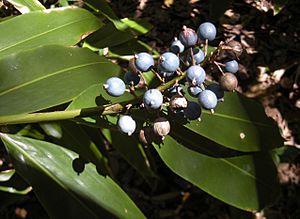Native ginger facts for kids
Quick facts for kids Native ginger |
|
|---|---|
 |
|
| Scientific classification | |
| Genus: |
Alpinia
|
| Species: |
caerulea
|
| Synonyms | |
|
|
Alpinia caerulea, often called native ginger, is a cool plant found in eastern Australia. If you visit the Atherton Tableland, you might hear it called red back ginger. This plant is a type of perennial herb, which means it lives for more than two years and doesn't have a woody stem like a tree. It can grow up to 3 meters tall! You'll usually find it growing in the shady areas under the tall trees in rainforests, gallery forests (forests along rivers), and wet sclerophyll forests.
What Does Native Ginger Look Like?
Native ginger plants have long leaves, usually about 40 centimeters (16 inches) long and 3 to 10 centimeters (1 to 4 inches) wide. When it blooms, it produces a flower spike, called an inflorescence, which can be 10 to 30 centimeters (4 to 12 inches) long. After the flowers, the plant grows small, round, blue fruits called capsules. Each capsule is about 1 centimeter (0.4 inches) across. Inside these blue fruits, there's a brittle outer shell that holds black seeds and a soft, white pulp.
How People Use Native Ginger
Native ginger is quite useful, especially for people who live in or explore the Australian bush.
Edible Parts of the Plant
- Fruit Pulp: The white pulp inside the blue capsules has a sour taste. Some people chew it when they are bushwalking to make their mouths watery, which helps when you're feeling thirsty. The black seeds are usually not eaten.
- Flavoring Spice: The whole fruit, including the seeds, can be dried and ground into a powder. This powder can be used as a spice to add a sour flavor to dishes.
- Herbal Teas: You can also use the dried fruits to make herbal teas. They give the tea a sour taste and a nice red color.
- New Shoots: The very center of new shoots that grow from the plant have a mild ginger-like flavor. These can be a great substitute for regular ginger in many recipes.
- Roots: The roots of the native ginger plant can also be used in cooking. They have a stronger, more earthy taste compared to the shoots.


